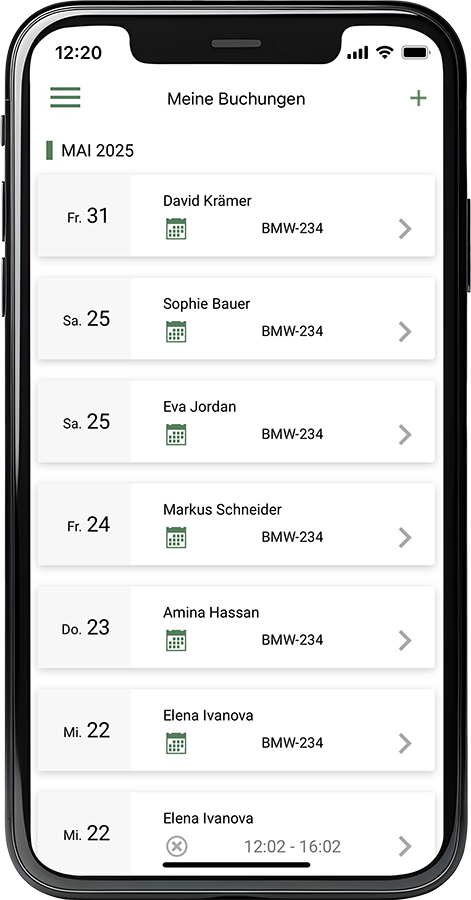The use of company cars should be clearly regulated within a company. Otherwise, there is a risk of misunderstandings and conflicts. To avoid this, it is advisable to draw up a company car policy. In this article, we look at the benefits of such a policy for your company and explain the most important points that should be included in a company car policy.
Contents
What is a company car policy?
With the help of a company car policy, companies define clear rules and guidelines for the use of company cars by employees. As an internal set of rules, it determines who is entitled to a company car and what obligations are associated with the use of the vehicle. Company car guidelines are not prescribed by law, so their content and regulations differ from company to company.
A well-thought-out and clearly formulated company car policy helps to create more transparency, control costs and ensure the safety of drivers. In addition, a company car policy can provide legal protection for the employer, as the employer can refer to the requirements set out in the policy in the event of a dispute. In general, a company car policy in the company ensures:
- Transparency: Clear rules that are openly communicated and practiced within the company reduce misunderstandings and ambiguities.
- Equal treatment: A company car policy ensures that all employees are treated equally and that decisions regarding the use of company cars are based on objective criteria.
- Cost control: With clear guidelines on vehicle selection, duration of use or the extent of vehicle use, a company car policy helps to control costs within the company and increase the efficiency of company car use.
- Prevention of damage and accidents: If it contains regulations on the maintenance, repair and training of drivers, a company car policy can increase the safety of employees and minimize potential accident risks. Ideally, it should also define clear procedures for reporting accidents and damage in order to ensure appropriate claims settlement.
- Limitation of liability: Such a policy should also set out the rules and responsibilities associated with the use of company cars. This limits the employer’s liability and provides legal protection in the event of damage or accidents.

More safety in the fleet?
Instruct your drivers in the safe handling of vehicles and how to behave in the event of accidents via an e-learning course.
The difference to the company car transfer agreement
A company car policy should not be confused with a company car transfer agreement. This is because the latter is a legally binding document between the employer and an employee that sets out the individual agreements and obligations of both parties. While a company car policy is generally valid for all employees, a company car transfer agreement is drawn up and tailored individually for each employee.
A company car transfer agreement generally refers to the regulations set out in the company car directive and supplements or specifies them. The contract may therefore contain individual exceptions or additional provisions.
Sample company car policy: These general regulations should be included
As mentioned at the beginning, companies have a certain amount of flexibility when it comes to the content of the company car policy. However, we have compiled the points that should definitely be taken into account below.
Company car entitlement
First determine which employees in the company are authorized to use a company car. This can depend, for example, on the position, hierarchy level or departmental affiliation. The amount of business travel or the number of business appointments can also be criteria. Always ensure that employees have a valid driver’s license.
Vehicle selection and equipment
To ensure that your vehicle fleet is uniform and reflects the company image, you should stipulate in the company car policy that you as the employer are responsible for selecting the vehicles. This gives you the sole power to decide on the vehicle model, fuel type, drive type and certain equipment features.
Maintenance and insurance
Next, clarify who is responsible for arranging maintenance appointments. Regular maintenance is intended to increase the safety of drivers, as potential problems and damage are detected at an early stage. Also record in writing the extent to which the company car is insured, e.g. through fully comprehensive insurance or liability insurance. The company car policy should also take into account who pays the excess in the event of a claim.

Consider these usage regulations in your company car policy
In addition to these general requirements, the sample company car policy also includes specific regulations on the use of company vehicles. For example, it should be clarified whether private use is also permitted and for how long the company vehicle may be driven.
Intended use
As the name implies, the use of company cars is mainly restricted to working hours. However, this does not mean that all journeys are permitted during this time. You should therefore clarify whether the company car should always be used as the preferred means of travel for business trips or whether employees may also use other means of travel for business purposes. The use of the company car abroad should also be clearly regulated.
Is the use of the company car for private purposes permitted? This should also be defined in the company car policy. If the vehicle may also be used privately, clear framework conditions must be defined for this. Are family members or other third parties also allowed to drive the company car? Are trips abroad permitted? Is there a mileage limit? You should also take these points into account.
Useful life
Specify when the entitlement to a company car begins and when it ends. Most employers refer to the start and end of the employment relationship as the time window. It is also possible that a company car can only be provided for the duration of a specific project. If the company car breaks down, it should be clarified what happens in this situation.
Sample company car policy: Observe financial and liability aspects
Your company’s own company car policy should also define financial and liability requirements. This includes, for example, the taxation of the company car or the procedure in the event of an accident.
Taxation
If private use of the company car is permitted, the employee must pay tax on the non-cash benefit arising from this. There are two methods for this: the 1% rule and keeping a logbook. In the first variant, a flat rate of 1% of the gross list price of the vehicle is taxed. Which option is more worthwhile depends on the extent of private use: a logbook is usually more worthwhile if there is little private driving. The company car calculator from Handelsblatt helps you to calculate the non-cash benefit.
Liability
As accidents happen even to the most experienced drivers, a company car policy should ensure a clear procedure. Therefore, define which protocol employees should follow in the event of an accident and how damage and accidents must be reported. You should also consider liability issues.
Costs
Whether expenses for fuel, cleaning, parking fees or parking tickets, the use of a company car incurs costs. But who does what? Which costs are borne by the employer and which by the employee should be clearly regulated in order to prevent misunderstandings. Fuel consumption is usually the biggest cost factor. If the company car may also be used for private journeys, it should be clarified who will then bear the costs.
Violations and return of the company car also part of the sample company car policy
The last part of a company car policy should deal with what happens in the event of breaches of the regulations and how the company car is to be returned.
Disciplinary measures
Companies should define possible consequences for employees who do not comply with or violate the requirements in the company car policy. This may involve a warning or reprimand or the loss of the company car entitlement.
Return
Finally, define the return of the company car. In what condition must the vehicle be returned? Define guidelines for the cleanliness of the vehicle, the condition of the bodywork and interior fittings and the functionality of the technical components. Where and to whom is the handover made?
More sustainability in the vehicle fleet through a company car policy
A company car policy is also an important tool for companies to contribute to environmental protection and meet their own sustainability goals. This can stipulate, for example, that only alternative drive systems may be selected when procuring new vehicles. A CO2 limit value can also be defined that can only be achieved with electric vehicles. An internal bonus-malus system rewards those who minimize emissions: The lower the emissions of the company car, the higher the employer’s contribution to the leasing rate. For vehicles with high CO2 emissions, however, a malus is applied to the leasing rate.
The most important facts about the sample company car policy
A company car policy contains clear rules and guidelines for the use of company cars in order to treat all employees equally, avoid misunderstandings and minimize potential legal problems.
There are no legal requirements, so companies can design the content of the regulations individually.
A company car policy differs from a company car leasing agreement in that it sets out generally applicable rules for all employees, whereas the contract contains individual agreements between the employer and employee.
Further Fleet Knowledge
If you liked this article and would like to know more about this topic, we recommend these articles.

Digital fleet management: Advantages for small fleets



